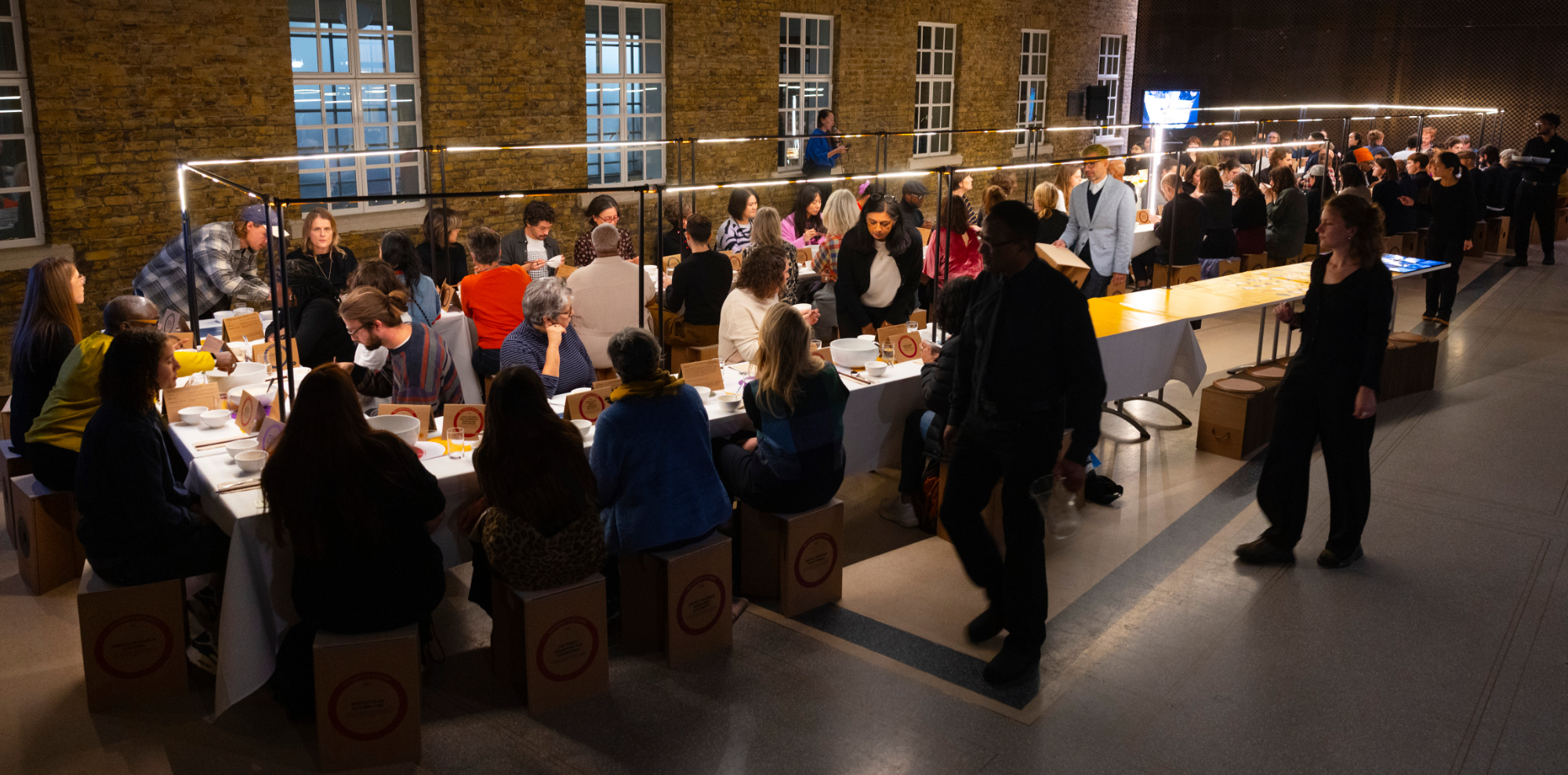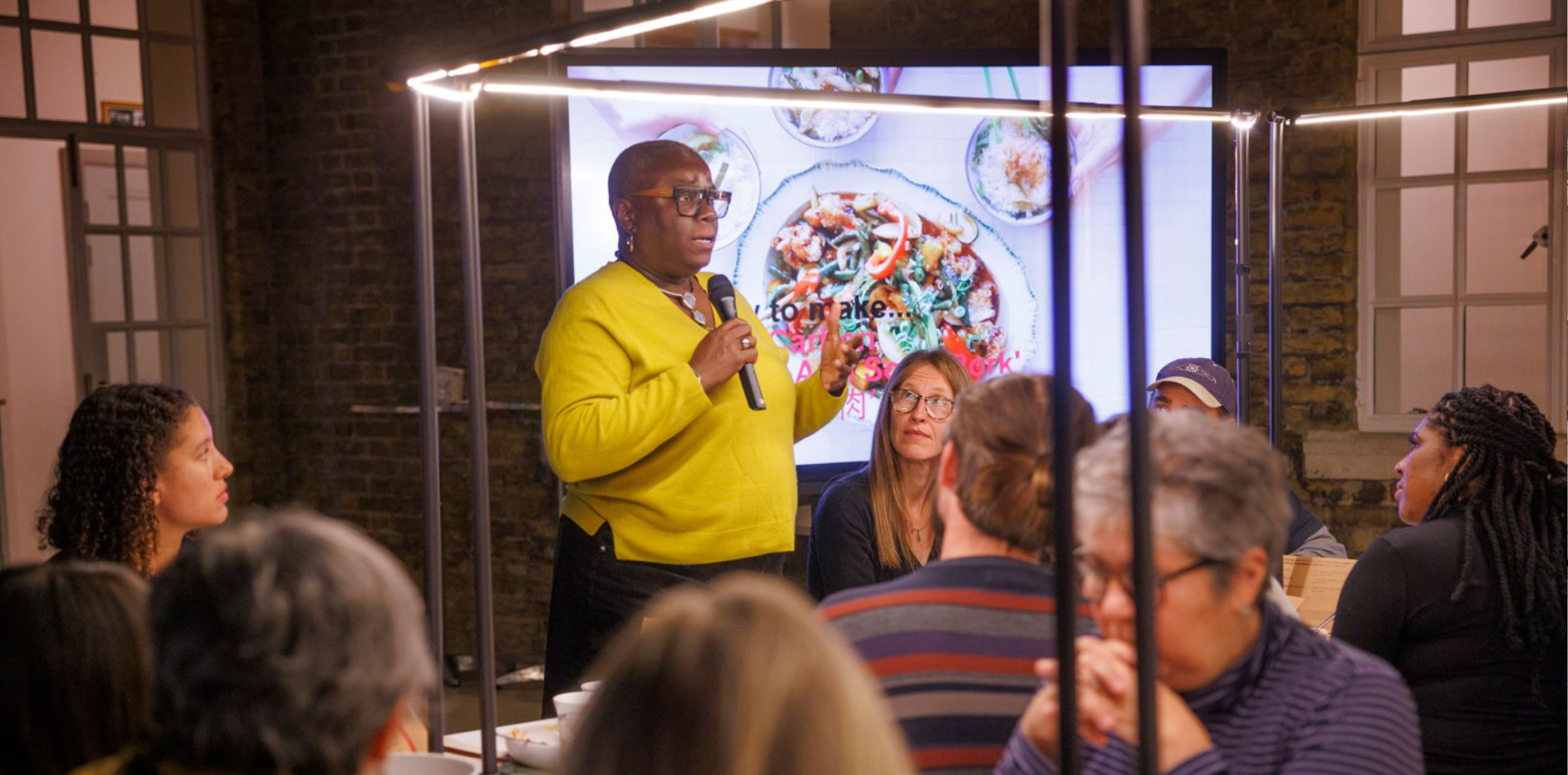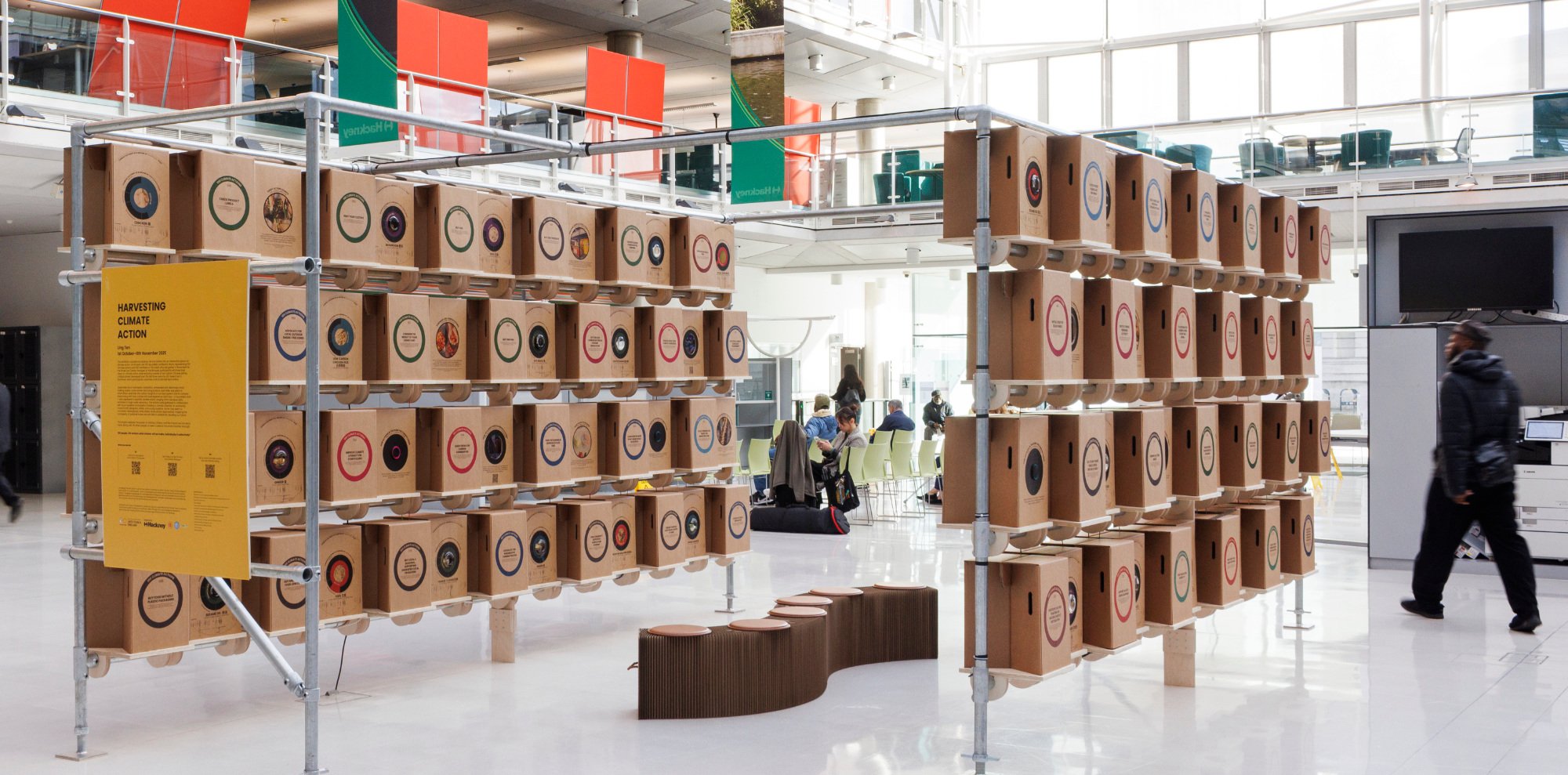
Low Carbon Chinatown
低碳唐人街
Low Carbon Chinatown is an award-winning environmental initiative combining urban interventions, installations, participatory platforms, and meal-as-performances to address the Climate Crisis by reimagining our food systems.
Using Chinese diasporic food culture as a starting point – due to its popularity and misperceptions around its environmental impact – it engages large groups of cross-generational diasporic East and Southeast Asians in the UK. Blending science, art and technology, they develop new ‘authentic’ sustainable ways of producing, sourcing and consuming food that evoke joy and memories.
Food, with its association to culture, is something we all have in common, breaking down barriers and bringing us all together. In the project, East and Southeast Asian communities worked with data scientists and notable chefs to create low carbon alternative recipes to typical Chinese dishes, exploring different ingredients, cooking techniques and food sources that, in combination, still retained a core essence of Chinese food culture. By presenting these dishes back to the wider public in through various formats such as multimedia installations, performative Supper Clubs and architectural Pop-Up using low carbon materials and processes, we showed how reimagining both food and design can contribute to a more sustainable future.
Low Carbon Chinatown is a project by artist and designer Ling Tan. It has been presented in cultural venues across the UK and Europe, as well as at public festivals including the London Design Festival, Compass Festival, and Ars Electronica. Recipient of a Seoul Design Finalist Award 2023, the initiative has been nominated for a number of other awards, including S+T+ARTS prize 2024.
Explore Past Presentations of Low Carbon Chinatown and various Resources For Climate Action to find out more about the project.
Past Presentations of Low Carbon Chinatown
Learn more about Low Carbon Chinatown through its previous presentations in different cultural and public venues.
Resources For Climate Action
Discover interactive tools, data maps, and stories that reveal the climate impact of our everyday choices. Explore low carbon Chinese recipes that retain authenticity while evoking joy and memories, 100 Climate Actions, and datasets uncovering our food system’s carbon footprint. Compare ingredients, trace their emission journeys, examine the impact of climate actions carried out individually and collectively, and reflect on how culture, food, community and climate intertwine.

Low Carbon Digital Cookbook
Explore a variety of low carbon recipes developed by UK-based East and Southeast Asians in collaboration with data scientists, acclaimed chefs, and food writers from East and Southeast Asian backgrounds. Gain insight into the carbon footprint of our food system by examining ingredients, cooking techniques, and food sourcing. Try cooking the dishes at home while reflecting on the climate impact of your own culinary practices.

100 CLIMATE ACTIONS
Explore 100 unique Climate Actions ranging from individual daily activities to large-scale advocacy, that examine the power of individual and the impact each of us can have, whether alongside 99 other people or scaled up to an entire borough.

Our Food System's Carbon Footprint
Explore a range of datasets that compare the environmental and carbon footprints of popular Chinese dishes in the UK. These datasets have been gathered over several years in collaboration with data scientists, cultural organisations, UK-based East and Southeast Asian communities, food writers, and chefs.

Towards a Low Carbon Cultural Food System
Compare the cultural and environmental impact of food ingredients used in low carbon dishes. Track each ingredient’s lifecycle from cradle to consumption, including its carbon footprint, transportation journey, historical origin, and significance within Chinese food culture.

The Scale of Our Impact
Compare the carbon footprint of a bowl of Low Carbon Wonton Dumplings with the emissions generated by various global activities carried out by people.
Hackney's Low Carbon Banquet
Hackney Town Hall, Borough of Hackney, London, 2025
The finale Hackney’s Low Carbon Banquet marked the conclusion of Hackney’s Low Carbon Chinatown project. At the banquet, 100 members of the public from different walks of life - scientists, environmentalists, teachers, students, families, civil servants, councilors and mayor - came together to enjoy a series of low carbon Chinese dishes, collaboratively developed over the last three years with UK-based East & Southeast Asian participants, scientists, and acclaimed food writers.
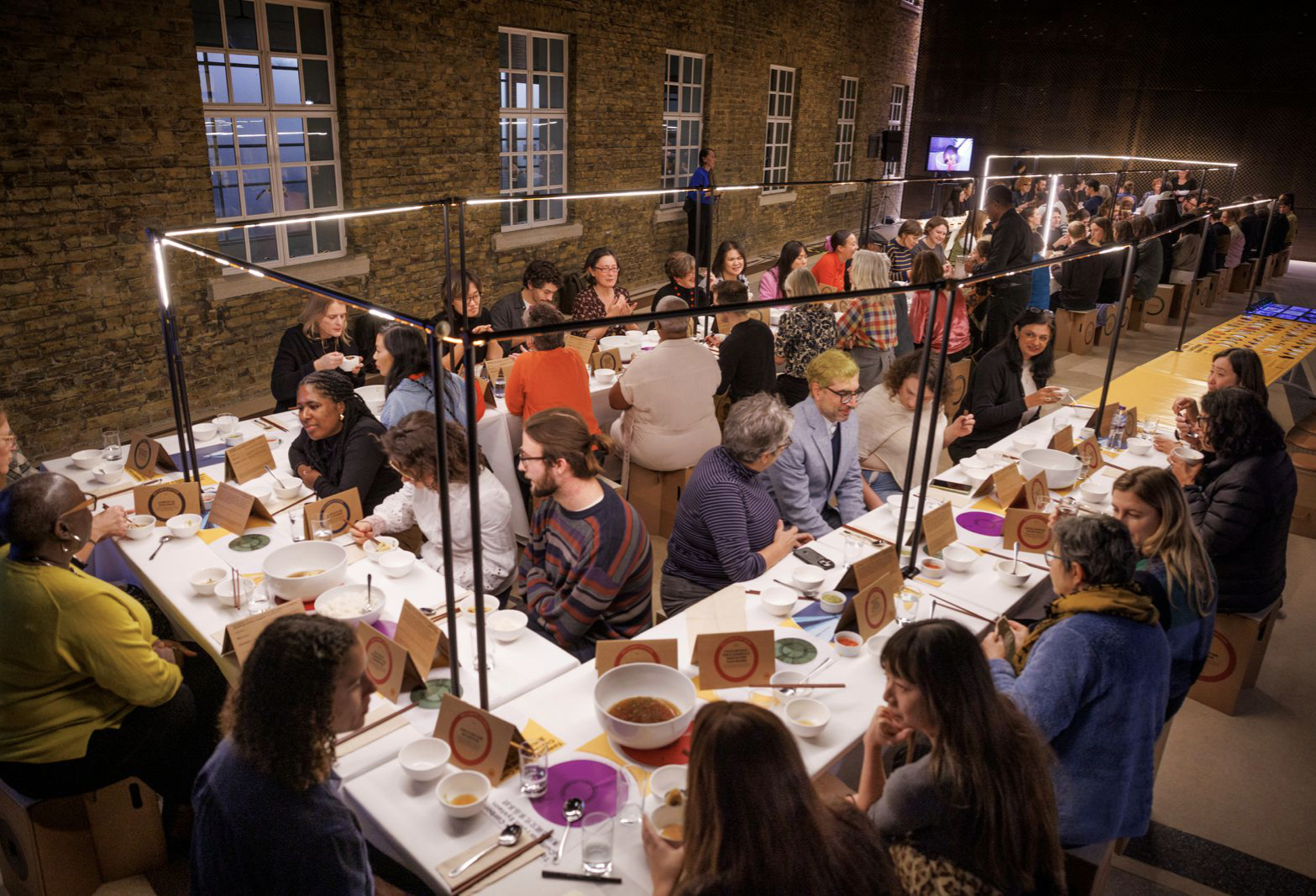



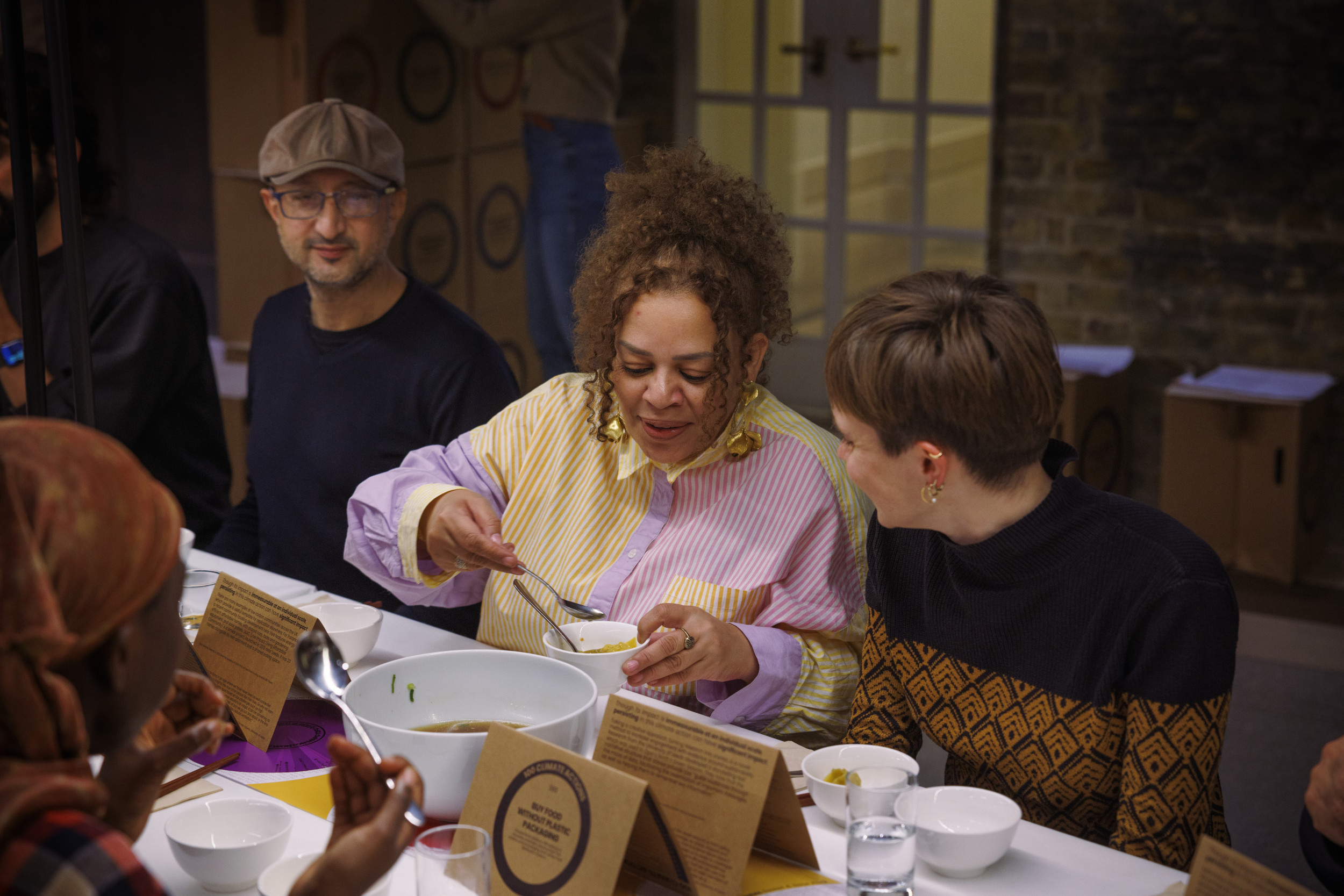


Participants sat with people they hadn’t met before to take part in open discussions and respond to provocations offered by project collaborators re presenting different sectors such as culture, science, farming, policy, and education. Together, they explored questions around how we tackle the climate crisis through our food system, what makes us willing to take climate action, and how to make our actions stickier and more impactful.





The Banquet featured 100 recyclable cardboard stools, deconstructed from the exhibition Harvesting Climate Action, representing 100 climate actions and 100 banquet participants. Each participant “harvested” a stool that led them to a specific table seat. At the table, they each received a climate action card that visualised the potential impact of their action if carried out individually and collectively.




The 100 Climate Actions range from individual daily activities to large-scale advocacy, gathered in collaboration with local residents in Hackney and experts, including climate scientists, a climate economist, council staff, designers, artists, and young students. Some may seem to contradict ideologically, while others share similar approaches, mapping the complexity of possible routes we can take in collectively deciding our future.
Quantifiable climate actions show their carbon savings at the individual scale, among a hundred people, and at the borough scale, while non-quantifiable actions, such as advocacy, draw on scientific research to convey their potential impact when carried out collectively. Each climate action card includes a quote from a climate scientist highlighting its broader environmental significance. At the end of the banquet, participants were asked to vote on each action in terms of its impact and daily uptake. Through the banquet experience, participants learned about and embodied their chosen climate action, and they took their stools home as a reminder of the experience and of the actions and choices they can make individually and collectively.
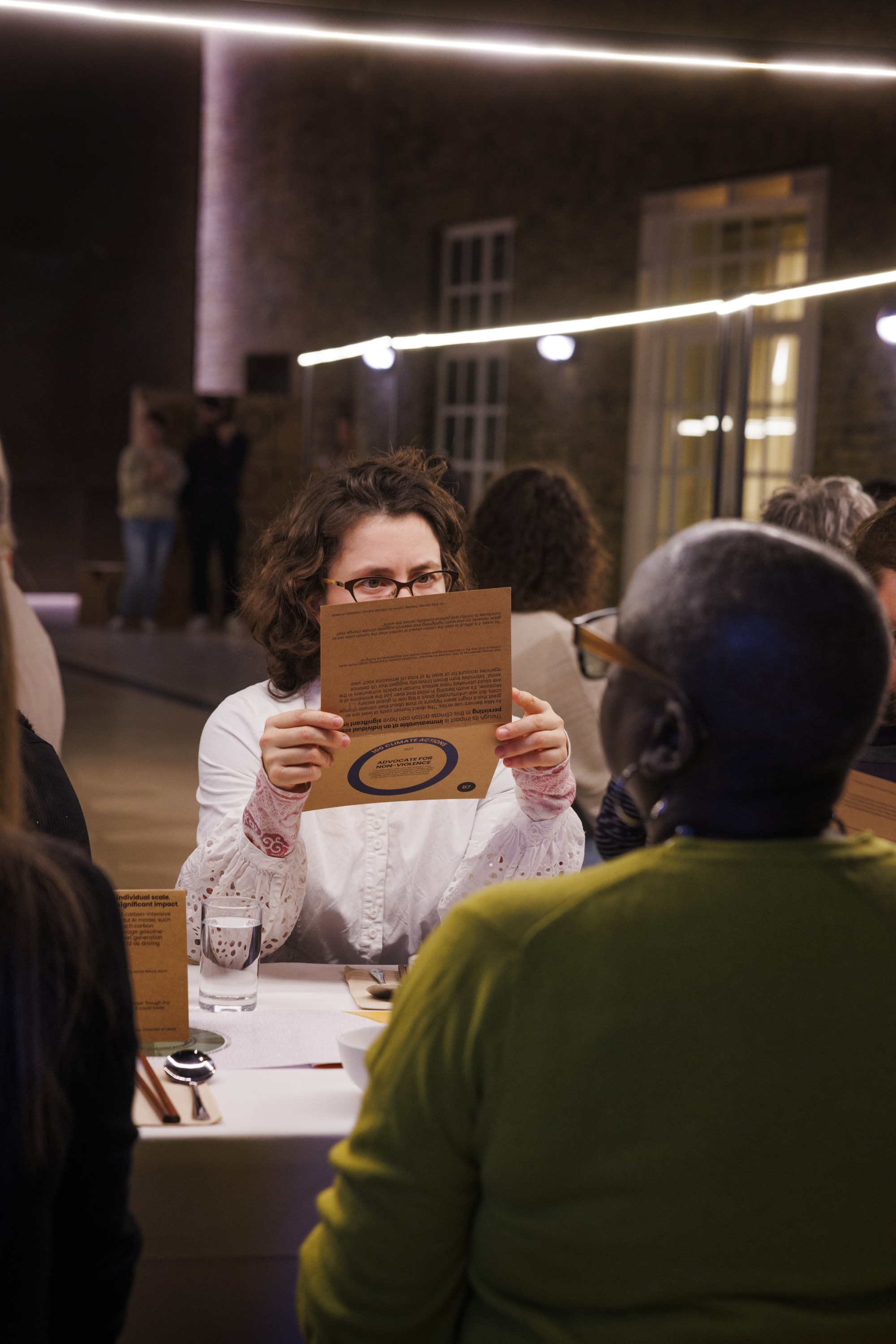

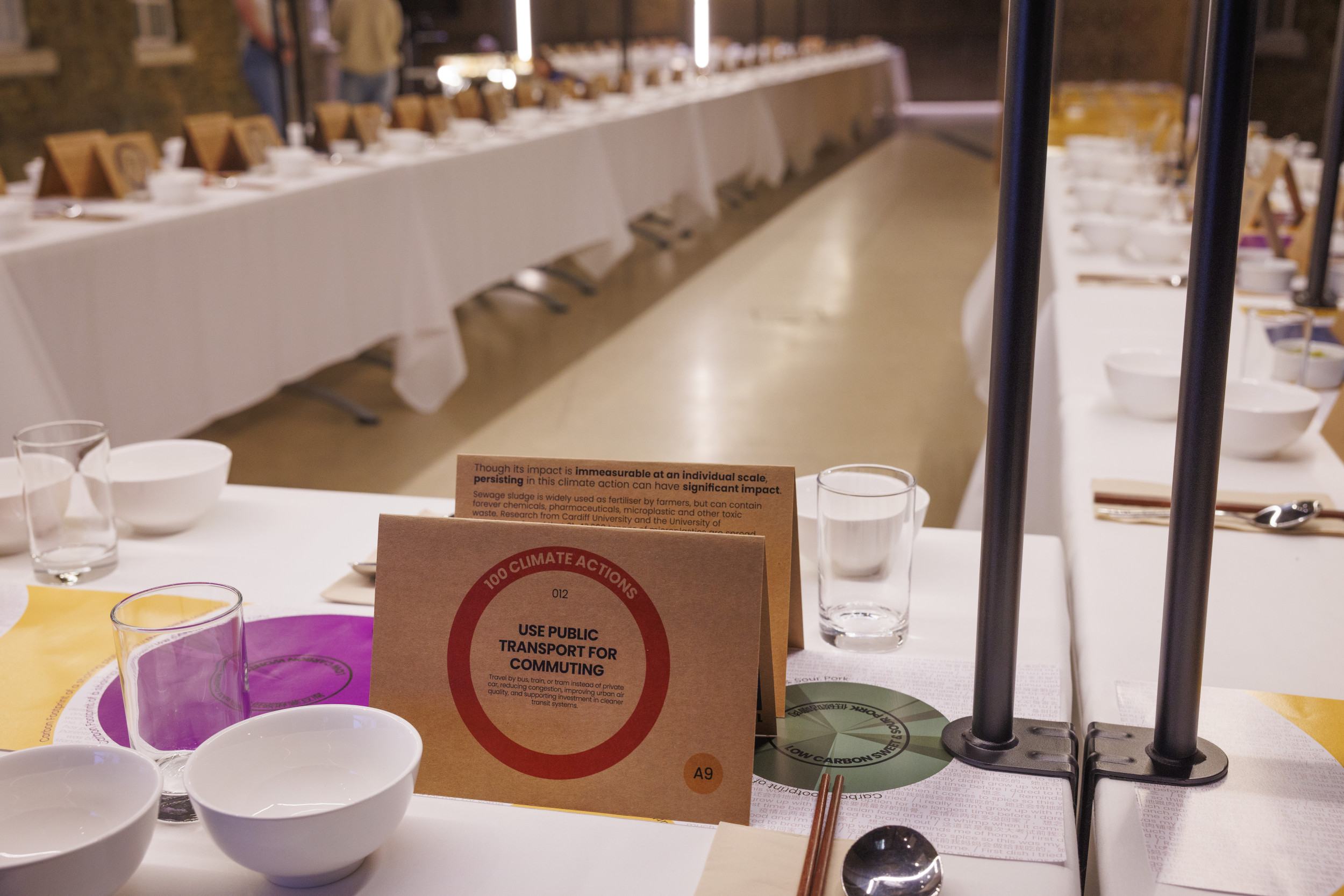

Harvesting Climate Action
Hackney Service Centre, Borough of Hackney, London, 2025
As part of Hackney's Low Carbon Chinatown, Harvesting Climate Action transformed Hackney Service Centre into a six-week-long interactive space for climate action. At its heart are 100 recyclable cardboard stools, representing 100 climate actions and 100 members of the public who later gathered in November 2025 for the finale Low Carbon Banquet. At the Banquet, participants will share their views on climate action while enjoying a series of low carbon Chinese dishes, collaboratively developed over the last three years by UK-based East & Southeast Asian participants, scientists, and acclaimed food writers.
– Video of Harvesting Climate Action. Videography by Nick Turpin. –
Assembled as a multimedia installation, embedded with datamaps, food-making videos, audio stories and living produce, each bite-size piece of information examines the carbon footprint of our food system and its complex intertwining with food culture and lived experience. Each box – a recyclable stool – also represents a specific climate action, ranging from individual daily activities to large-scale advocacy. The actions were gathered in collaboration with local residents and experts including a climate scientist, an economist, council staff, designers, artists, and young students. Some may seem to contradict ideologically, while others share similar approaches, mapping the complexity of possible routes we can take in collectively deciding our future.
The project explores the power of an ordinary citizen, and the impact we can each have, along with 99 other people, or even scaled to the entire Hackney borough.
100 people, 100 actions: what choices will we make, individually & collectively?



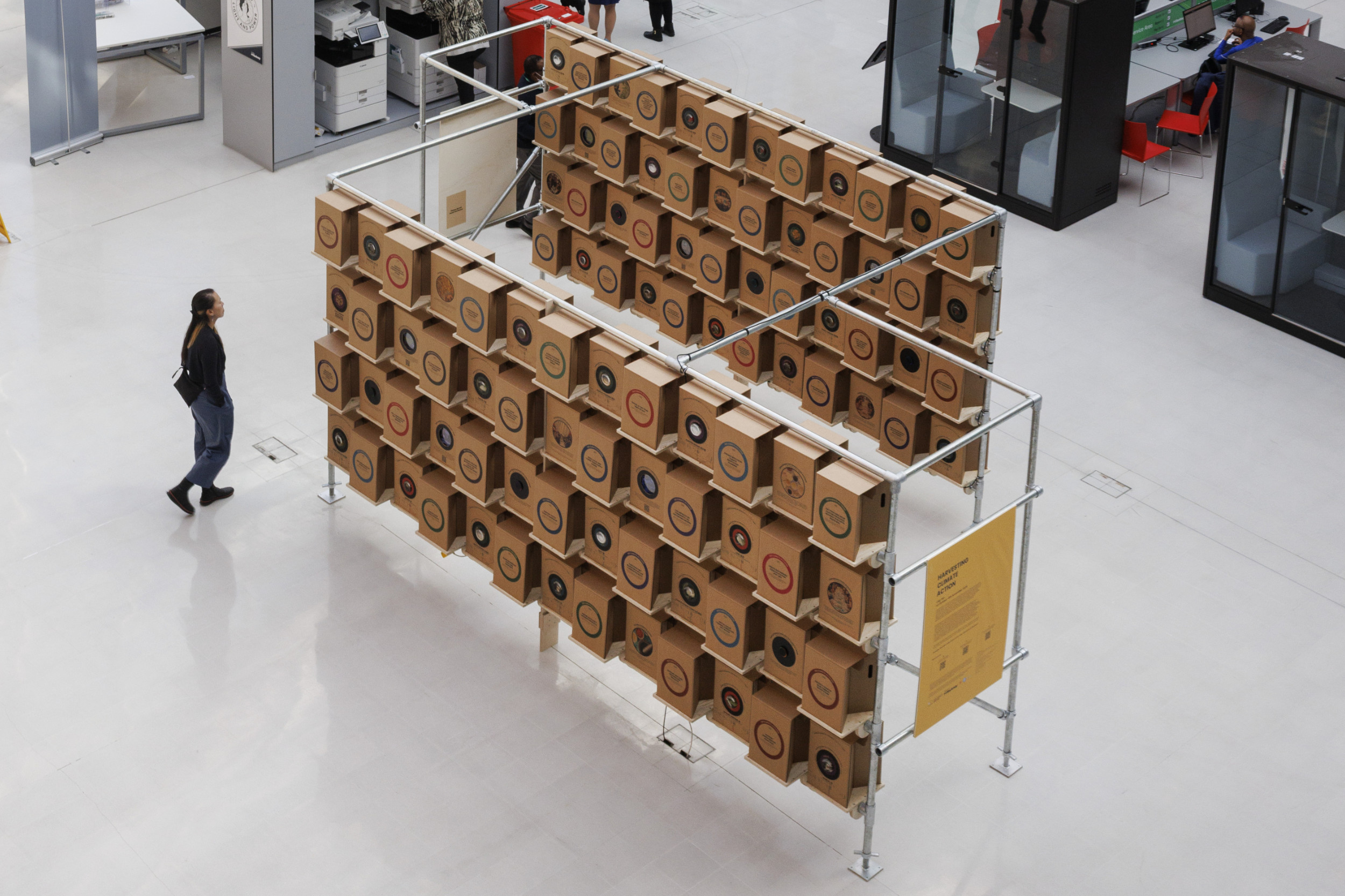






– Photography Nick Turpin –
Hackney’s Low Carbon Chinatown
Hackney's Low Carbon Chinatown is a partnership with the Climate Team at Hackney Council to develop a series of public interventions across the borough that explore climate action through local food systems.
The project took place over several months and culminated in a six-week-long exhibition, Harvesting Climate Action, a Low Carbon Children Banquet for 60 children, and a finale of Hackney's Low Carbon Banquet for 100 members of the public. The banquets featured a series of low carbon Chinese dishes developed as part of Low Carbon Chinatown, in collaboration with East and Southeast Asian community members across the UK, as well as scientists, food writers, and chefs. The vegetables used for both banquets were grown or sourced locally by local farmers and a school.
Hackney’s Low Carbon Chinatown is a project by Ling Tan, supported by the Climate Team in Hackney Council and public funding by the National Lottery through Arts Council England, delivered in partnership with Growing Communities, Gainsborough Primary School and MadLeap.
Special thanks to:
Stephanie Li & Ander Zabala at Hackney Council
Tim Jones, Ronald Springer & Facilities Team at Hackney Service Centre
Uyen Luu
Neil Eakapong
Jenna Clark, Rab Brownell & Debby Lewis at Gainsborough Primary School
Participating students from Gainsborough Primary School
Rokiah Yaman & Katrina Wright at MadLeap
Danny Fisher & Sophie Verhagen at Growing Communities
Catherine Chong at CLEAR
Dr Alice Garvey at Priestley Centre for Climate Futures
Rachel Bronstein at Design Council
Alexie Sommer at Design Declares
Usman Haque
Studio Makecreate
Jennie Gilman

Low Carbon Pop-Up Structure
London Design Festival 2022
As part of Low Carbon Chinatown, a Pop-Up Structure built from low carbon materials and processes is installed in Chinatown, used to host a series of sit-down tastings featuring low carbon dishes chosen and developed by London’s East and South East Asian communities alongside a data scientist and acclaimed Asian food writers. The Pop-Up was featured as part of the London Design Festival.
The Pop-Up Structure is designed by Ling Tan and Usman Haque as part of HAQUE TAN, supported by structural engineers Atelier One, fabricated by Gary Campbell and production managed by Nick Murray.

– Project Trailer for Low Carbon Chinatown at London Design Festival 2022 –


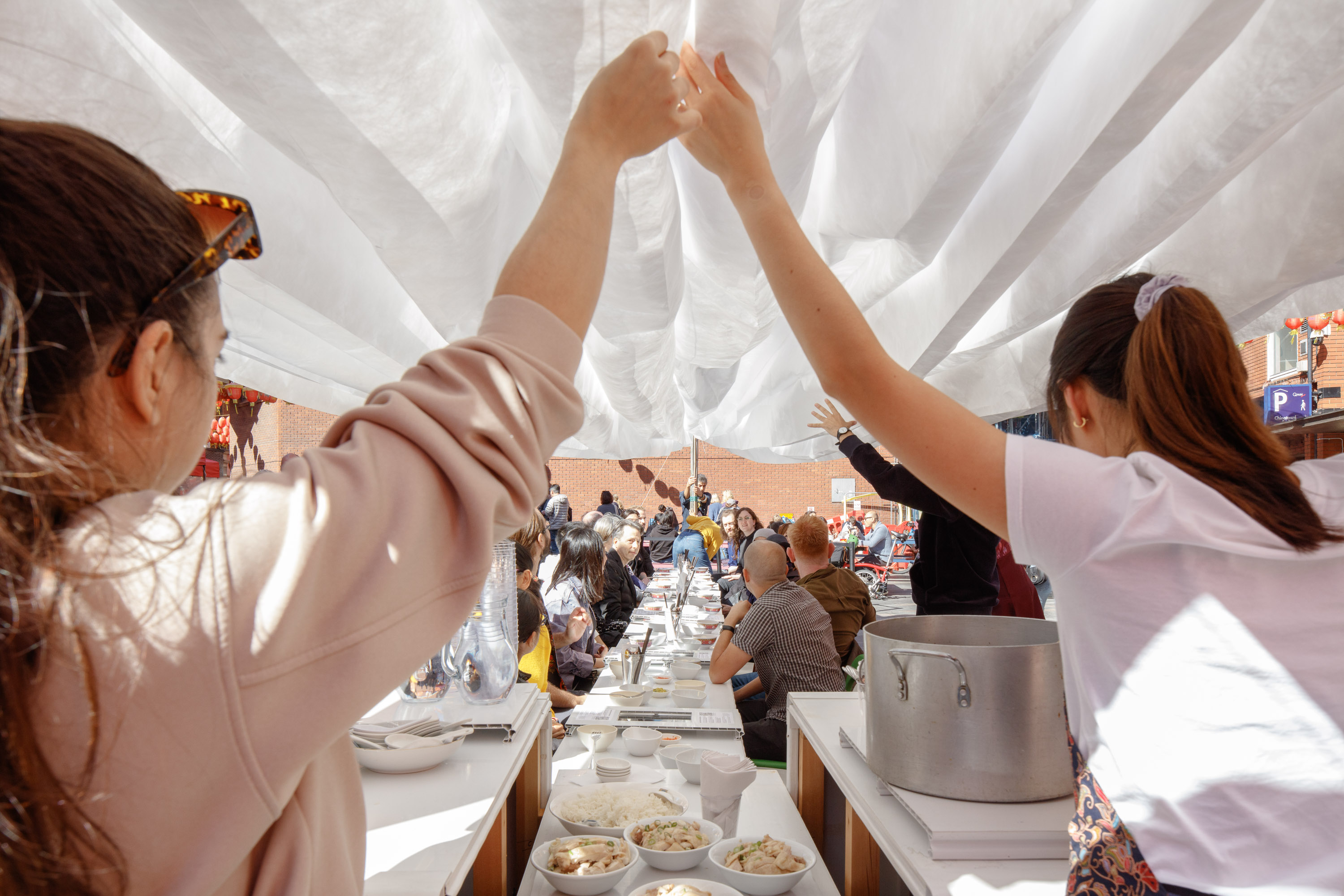

– Photography by Luke O'Donovan –
The Pop-Up Structure is intended to showcase other aspects of tackling the Climate Crisis by adopting low carbon approaches to designing and fabricating sustainable touring works. Designed to be easily assembled/disassembled and transported by a small electric van, the structure is made from a range of materials that are sustainable/low-carbon or easily recyclable in existing facilities once touring ends.
The Structure has four key components: a Preparation Unit, a long Banquet Table, a Pleated Canopy, and borrowed chairs from the Chinatown community. These are made primarily from three materials: These are made primarily from three materials:
• UK grown Bamboo for structural members
• EnviroHoard™ for cladding and surfaces
• Tyvek for sun/rain protection

UK Grown Bamboo
The bamboo used in the Pop-Up Structure was grown and harvested from Ness Botanic Gardens in Liverpool (UK).
Borinda bamboo originated from mountainous Tibet and was first propagated in Shropshire (UK) many years ago by one of a few UK bamboo experts, Michael Brisbane. Borinda bamboo is a hardy plant that thrives in different climates. When harvested, it is a strong and sustainable material with many uses in different industries such as construction and design. It has a powerful capacity for capturing carbon, particularly as a result of its growth rate. In contrast to trees, bamboo plants regenerate quickly after being harvested. There is a growing initiative in the UK to explore the use of bamboo as a future sustainable building material for the planet. The bamboo used in the Pop-up was kindly donated by Liverpool City Region.

EnviroHoard
The surfaces, counters and cladding of the Pop-Up Structure are fabricated using EnviroHoard™ panels, a recyclable alternative to typical construction hoarding panels.
Developed by UK-based Panthera Group, and normally used in construction sites as hoarding, the panels are made of post-production recycled PVC. In contrast to normal plywood hoarding, they are typically reused up to three times on different sites over several years , and then recycled and processed again to be used as new hoarding panels. Panthera Group has kindly donated Class B pre-used EnviroHoard panels to the project.

Tyvek
The canopy of the Pop-Up Structure is constructed from pleated Tyvek. While not strictly speaking low-carbon itself, Tyvek is a lightweight paper-like substance that can be easily repurposed and recycled.
It is lightweight, waterproof and a high-value recyclable material, often used in banners and disposable protective wear, which can be mechanically recycled into products such as underground cable protection piping, automotive parts, blown film, packaging cores and trays. Made with 100% HDPE, Tyvek is readily recyclable for its second life in existing recycling facilities. Tyvek from the Pop-up will be repurposed and recycled once it reaches the end of its touring.
Borrowed Chairs From The Chinatown Community

In addition, all the chairs used in the Pop-Up have been lent to us by different nearby Chinatown businesses, placing the project within a local sharing economy – with thanks to Min Tea, Wing Wing, Pot Pot Matatang, Jin Li, New Canton, Ku Bar, Gourmet Kitchen, Shanghai Modern, Candy Cafe, Imperial China, Mi Canteen, Monga, Dumplings' Legend, Leong's Legend, Real Beijing, Shu Xiang Ge, Wan Chai Corner and New China.
Leeds Low Carbon Pop-Up
Compass Festival 2024
Hosted in Leeds Kirkgate Market (one of Europe's largest indoor markets) over two-weeks period, the Leeds Low Carbon Pop-Up is an experimental food farm and data showcase, nurturing and stocking food ingredients (locally, regionally grown and globally sourced) that was later used to prepare a large-scale Leeds Low Carbon Supper Club for 60 people hosted at Kirkgate Market on 15 November 2024. The Pop-Up was featured as part of Compass Festival 2024.
Made entirely from recycled materials, the Pop-Up is designed and fabricated with minimum material waste. Every bit of physical waste produced in the project is documented and showcased at the Pop-Up to reflect the actual carbon footprint of a design & art production like this.





– Photography by Jules Lister –
Visitors get to explore the cultural and environmental impact of food ingredients used commonly by Leeds locals, learn about the lived experience of Leeds' Chinese migrants and their climate actions, and acquire resources on how to cook low carbon Chinese dishes at home themselves.
Leeds Low Carbon Pop-Up is designed by Ling Tan, and fabricated by Matthew Sykes-Hooban. With production support from Compass Festival.




– Photography by Jules Lister –
Leeds Low Carbon Supper Club
Compass Festival 2024
Hosted after-hours in Leeds Kirkgate Market (one of Europe's largest indoor markets), 60 guests (including local community champions and politicians), gathered for a communal feast featuring a series of low carbon Chinese dishes developed collaboratively with UK-based East & Southeast Asian community members, data scientists, and acclaimed food writers, as part of Low Carbon Chinatown. The food ingredients (e.g oyster mushrooms, chillis, spring onions) used to prepare the feast were harvested from the preceding Leeds Low Carbon Pop-Up and the Supper Club scene was assembled out of the recycled component parts used to construct the Pop-Up. The Supper Club was featured as part of Compass Festival 2024





– Photography by Jules Lister –
A custom 20-metre Low Carbon Table Runner stretches across the full length of the communal tables. Made from reusable woven bamboo fabric, it visualises the carbon footprint of ingredients used in the featured low-carbon dishes compared to their traditional counterparts. Overlaid with sentiments from East and Southeast Asian participants about the dishes, the runner compares the environmental impact of dishes while also highlighting the environmental benefits of choosing low-carbon food.
Leeds Low Carbon Supper Club is designed by Ling Tan, and fabricated by Matthew Sykes-Hooban. With production support from Compass Festival.

– Custom Low Carbon Table Runner developed for Leeds Low Carbon Supper Club, showing the carbon footprint of the 4 low carbon Chinese dishes based on a communal meal for 4 people–

– Custom Low Carbon Table Runner developed for Leeds Low Carbon Supper Club, showing the carbon footprint of the 4 low carbon Chinese dishes based on a communal meal for 4 people. Zoom or pan to view image. –




– Photography by Jules Lister –
Low Carbon Chinatown Tastings
Science Gallery London 2025
As part of Science Gallery Friday Late, we invited 72 guests to take part in two rounds of communal tastings of Low Carbon Wonton Dumplings. Through provocations from six guest experts, guests engaged in discussions on the environmental impact of our food system, the gap between actual and prescribed climate actions, and the complex ways in which food culture, identity, and habits influence sustainable food choices.
The guest experts included cookbook author Shu Han Lee, Lau Chair of Chinese International Relations Astrid Nordin, Climate advocate Adithi Sathiyan, Author & Entrepreneur Alexandra Deschamps-Sonsino, Researcher & Artist Angela YT Chan and King's College Researcher & Lecturer Thomas White.




– Photography by George Torode –
A custom Low Carbon Table Runner stretches across the full length of the communal tables. One side visualises the carbon footprint of a Low Carbon Wonton Dumpling Soup, showing the travel emissions and distance of each ingredient from production to consumption. The other side illustrates the cultural footprint of the dish by tracing the historical origins of each ingredient and mapping how many ingredients are connected to each country of origin. The runner highlights the complexity of our food system—the pursuit of sustainability, and the cultural impact it can have over time.

– Custom Low Carbon Table Runner developed for Science Gallery Tastings –

– Custom Low Carbon Table Runner developed for Science Gallery Tastings. Zoom or pan to view image. –
Each guest was invited to take home a climate resource in the form of a custom Low Carbon Table Mat. The mat compares the carbon footprint of a bowl of Low Carbon Wonton Dumplings with the emissions generated by various global activities—ranging from a round trip between London and Barcelona, to the production of a 16-inch Apple MacBook Pro, to the average daily carbon footprint of individuals in the USA, the UK, and China, and even that of a UK military soldier. It visualizes the environmental impact of everyday actions, helping to put into perspective the scale of individual behavior—and the collective influence we can have on the climate.



– Custom Low Carbon Table Mat compares the carbon footprint of a bowl of Low Carbon Wonton Dumplings to the emissions generated by various global activities –

– Custom Low Carbon Table Mat compares the carbon footprint of a bowl of Low Carbon Wonton Dumplings to the emissions generated by various global activities. Zoom or pan to view image. –
Low Carbon Children Banquet
Gainsborough Primary School, Borough of Hackney, London, 2025
A special Low Carbon Children's Banquet was hosted for 60 students from Gainsborough Primary School as part of Hackney's Low Carbon Chinatown. The students gathered to sample four low carbon Chinese dishes that will be featured at the finale of Hackney's Low Carbon Banquet, while learning about various climate actions they can take at home on their own and together with their friends and families.

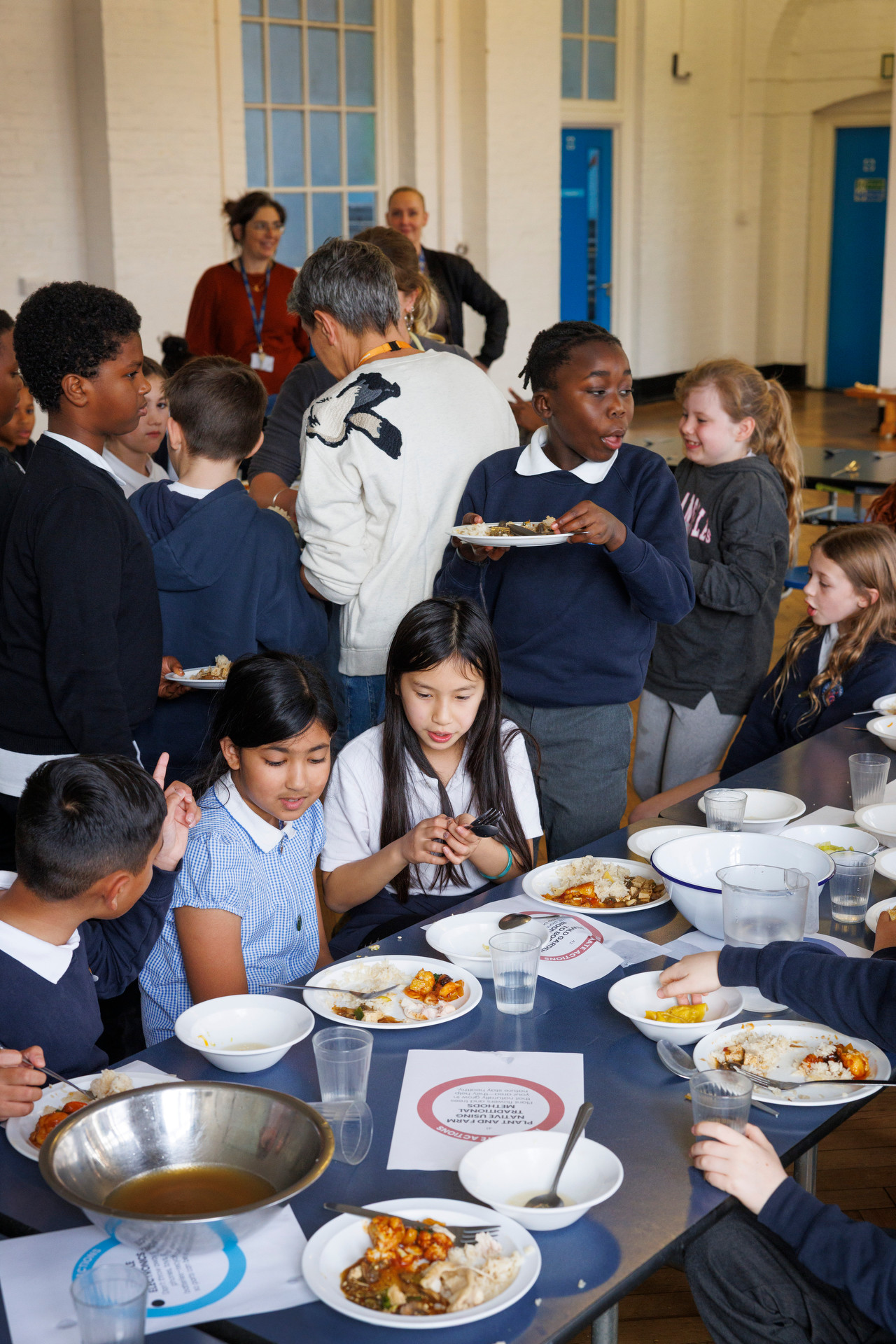
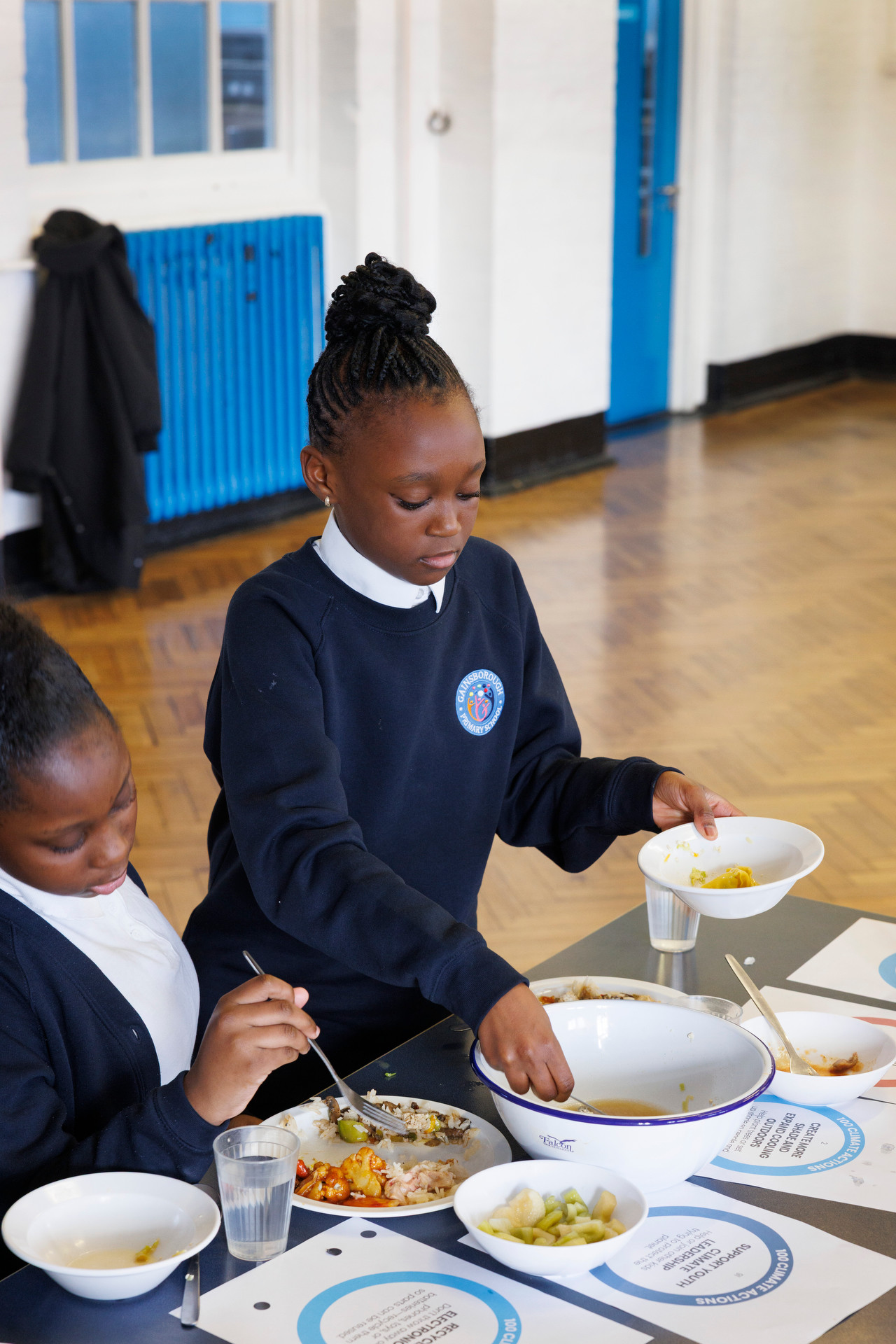

The students also took part in hands-on workshops where they learned how to tackle the climate crisis through food systems by making some low carbon condiments themselves.
Over several months, the students took part in Hackney's Low Carbon Chinatown by growing and nurturing some of the vegetables required for the banquets, and by helping to prepare key low carbon condiments. They also collaborated with local food writer and photographer Uyen Luu to document the creation of a new set of low carbon Chinese dishes and condiments.




Special thanks to Gainsborough Primary School's Executive Headteacher Jenna Clark and the teachers who supported the project, including Rab Brownell and Debbie Lewis.
Low Carbon Chinatown Feature
Ars Electronica 2024
Low Carbon Chinatown was featured at Ars Electronica 2024 as part of the S+T+ARTS Exhibition where the project was nominated for the S+T+ARTS Prize. As part of the exhibition, Low Carbon Food System Workshop was hosted where the audience engaged in discourse about migrant food culture, while learning about the food system through the lens of diverse Chinese food. This includes exploring different low carbon ingredients, cooking techniques and food sources that, in combination, still retain the core essence of authentic Chinese food culture.




Low Carbon Chinatown Residency
Compass Live Art
What motivates us to take action on something like the Climate Crisis, that, as individuals, we feel we can only have a minimal impact on?
Subverting the use of social media to interject complex and, at times, activist messages, these short cooking-documentary films follow 4 Leeds residents: a 79-year-old immigrant from Hong Kong; a 41-year-old immigrant from China; a 25-year-old university student from China; and a 18-year-old high school student from Hong Kong.
In their own home environments, they each prepare their own version of a low carbon Salt and Pepper ‘Prawns’ dish, while talking about their experience living in the UK as migrants, and their relationship to climate change. The films invite the audience to examine how different ages, backgrounds, heritages, and life experiences affect the way people take action in tackling the Climate Crisis. Explore their low carbon recipes using the Low Carbon Digital Cookbook.
The residency project is by Ling Tan, supported by Compass Live Art. Special thanks to film participants Man Chiu Leong, Bei Gao, Haojin Wang and Stephen Wong, Lychee Red Chinese Seniors and Mafwa Theatre & Lincoln Greeners.
– Bei Gao –
– Man Chiu Leong –
Low Carbon Chinatown Supper Club
Manchester Museum, Barking Riverside
The Supper Club brings the Low Carbon Chinatown experience indoors into neighbourhoods and institutions and engages large groups of audience on the environmental impact of our food systems through a communal feast featuring a series of low carbon Chinese dishes developed in Low Carbon Chinatown.


Audiences engage with issues surrounding climate change through an interactive, educative and delicious experience. Before the meal begins, the audience shuffle their seating positions based on a series of questions that help them examine their individual and collective opinions on the climate crisis. As they discuss and negotiate with each other, a live camera feed provides an overview representation of everyone’s collective perspective. Once seated, audiences are presented with the low carbon dishes to taste, alongside the data science behind each dish. While having the meal, they take part in an interactive mini workshop session that helps them better understand the carbon footprint of food, and watch the making of the low carbon dishes on a projected screen.
Low Carbon Chinatown Supper Club is a project by Ling Tan, previously presented in Manchester Museum and Barking Riverside Wild Ecology Centre.


Low Carbon Food System Workshops
Hackney, Newham, Chinatown
The workshop format engages participants in discourse about migrant food culture, while learning about the food system through the lens of diverse Chinese food. This includes exploring different low carbon ingredients, cooking techniques and food sources that, in combination, still retain the core essence of authentic Chinese food culture.
Kicking off in London as our first stop, in the iteration, a group of almost sixty London based East & South-East Asian participants came together over the summer in a series of engagement workshops to experiment with cooking Chinese dishes while reducing its carbon footprint. They collectively develop a set of low carbon (footprint) Chinese food recipes, based on traditional Chinese cuisines that are popular in the UK, with the help of a data scientist Raphael Leung and acclaimed food writers Mimi Aye, Uyen Luu and Shu Han Lee. Visit our Low Carbon Digital Cookbook to learn about the various low carbon dishes that were developed in the participatory process.
Making A Low Carbon Hainanese Chicken Rice
MiMi Aye x Chinatown
How do we cook our favourite dishes using a lower carbon footprint approach? UK-based Burmese Chef and Food Writer MiMi Aye explored cooking low carbon Chicken Rice with a group of participants living in central London, focusing on reducing the carbon footprint using cooking techniques. The result is a low carbon version of the dish – with chicken still included!

Supported by London Chinese Community Centre.
Making A Low Carbon Sweet and Sour 'Pork'
Uyen Luu x Hackney
UK-based Vietnamese food writer and photographer Uyen Luu worked with a group of participants living in and around Hackney to develop a low carbon (footprint) version of a classic and popular sweet and sour pork dish with a reduced carbon footprint through buying and growing locally grown produce. No one misses pork once they taste this!

Supported by Hackney Chinese Community Centre.
Making A Low Carbon Wonton Dumpling Soup
Shu Han Lee x Newham
Who doesn't love dumplings? Traditional wonton dumpling uses pork and prawn in the fillings. In this version, UK-based Singaporean food writer Shu Han Lee worked with a group of participants from Newham to develop a low carbon (footprint) of the wonton dumpling soup with vegetarian fillings that taste like meat and wrappings that are made in London.

Supported by Newham Chinese Association and Royal Docks.
– Food photography by Uyen Luu and styling by Sam Dixon –

Low Carbon Chinatown is a project by Ling Tan, originally commissioned by Kakilang.
Leeds Low Carbon Chinatown is commissioned by Compass Festival.
Hackney’s Low Carbon Chinatown is supported by the Climate Team in Hackney Council and public funding by the National Lottery through Arts Council England.
With contributions from data scientist Raphael Leung, climate scientist Dr Alice Garvey, climate economist Catherine Chong, food writers MiMi Aye, Uyen Luu and Shu Han Lee, chef Neil Eakapong, designer Usman Haque, production support Nick Murray, Holly Gibbs & Jennie Gilman, fabricator Gary Campbell and Studio Makecreate, structural engineer Atelier One, community film participants Man Chiu Leong, Bei Gao, Haojin Wang & Stephen Wong.
With support from Arts Council England, Compass Festival, Manchester Museum, Barking Riverside, Royal Docks, Growing Communities, Gainsborough Primary School and MadLeap. With community support from London Chinese Community Centre, Hackney Chinese Community Centre, Newham Chinese Association, Mafwa Theatre, Lincoln Greeners, Lychee Red Chinese Seniors & Gainsborough Primary School.





